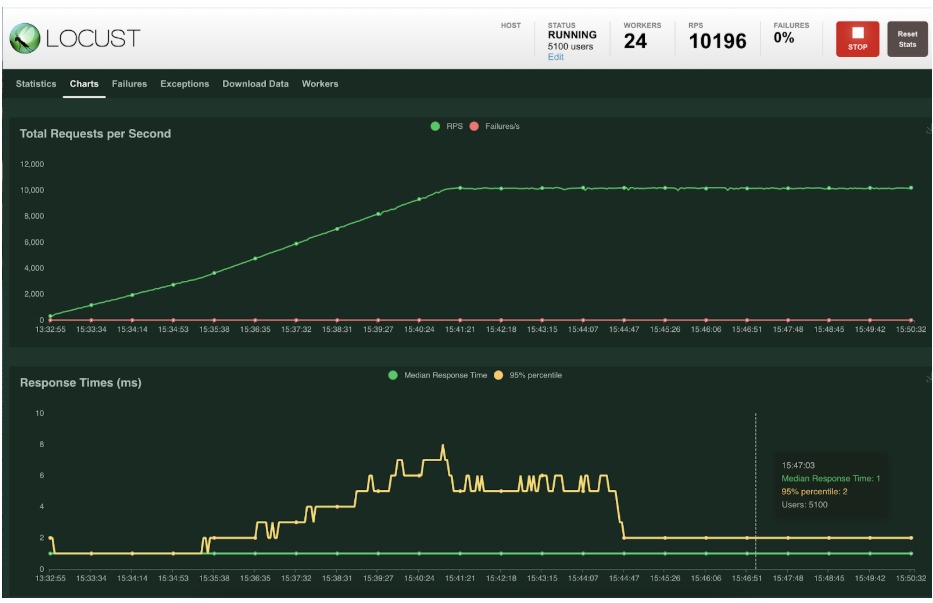Generating MongoDB workloads using Locust
Locust is an easy to use, scriptable and scalable performance testing tool written in Python. It allows you to easily code up the MongoDB operations in pure Python and visualise their execution in a browser by plotting the number of requests per second and p50 and p95 latencies in real time.
Locust can run on a laptop in standalone mode. It requires almost no configuration and is easy to get started with. When required however, Locus can be run in a distributed mode - with a single primary that aggregates and exposes the stats and multiple workers that can drive thousands of queries per second against your MongoDB deployments.
This is a basic template that can be extended to build a custom workload. It contains the boilerplate code that is needed to get started. Sample functions to insert new documents (single and bulk), run finds and aggregation pipelines are also implemented for reference.
To get started you should have python 3 abd git installed. On Amazon Linux 2 this can be done using the following commands:
sudo yum install git -y
sudo yum install python3 -yPlease clone this repository, create the virtual environment and install the prerequisites using the following commands:
git clone https://github.com/sabyadi/mongolocust
cd mongolocust
python3 -m venv venv
source venv/bin/activate
pip install -r requirements.txtOnce the requirements are installed, you need to update the cluster credentials in the settings.py to match your MongoDB deployment and copy over your modified load_test.py.
The test can be started locally in standalone mode using the following command:
(locust) adilet@MBP16 mongolocust % locust -f load_test.py
[2021-08-15 20:33:45,238] MBP16.local/INFO/locust.main: Starting web interface at http://0.0.0.0:8089 (accepting connections from all network interfaces)
[2021-08-15 20:33:45,247] MBP16.local/INFO/locust.main: Starting Locust 2.1.0Finally, you can open the browser and navigate to http://127.0.0.1:8089 to start the test.
Running Locust in distributed mode
Locust can be run in a distributed mode, where the primary instance controls the workload, exposes a client GUI and gathers the stats from multiple worker instances executing the tests. This mode is required to generate higher throughput. The primary and workers can be placed within the same cloud provider region as the Atlas cluster to minimize the network latencies.
The steps required to run the primary instance:
sudo yum install git -y
sudo yum install python3 -y
git clone https://github.com/sabyadi/mongolocust
cd mongolocust
python3 -m venv venv
source venv/bin/activate
pip install -r requirements.txtThe right workload file needs to be copied over and the connection string needs to be modified in settings.py.
Finally, the primary instance can be started as follows:
./run_distributed_primary.shPlease note the primary's IP address since it will be required to access the GUI as well as to configure workers. The workers use the same default TCP port of 8089 to establish a connection to primary.
The steps required to run a worker (can be repeated multiple time on multiple VMs):
sudo yum install git -y
sudo yum install python3 -y
git clone https://github.com/sabyadi/mongolocust
cd mongolocust
python3 -m venv venv
source venv/bin/activate
pip install -r requirements.txtThe worker instances can be stared using the following command (the <PRIMARY_HOST_IP> needs to be replaced with the right IP address from the previous step):
./run_distributed_worker.sh <PRIMARY_HOST_IP>You can run multiple instances of the worker on every machine, since the workers are single threaded. Multiple machines can be used to run the workers.
Automated deployment via Terraform
Terraform is an open-source tool to manage the entire lifecycle of infrastructure using infrastructure as code. The folder terraform contains a set of configuration files which will deploy an Atlas Cluster, database user and a private endpoint on AWS as well as a Locust master and custom amount of workers on AWS. The complete deployment process will take around 10 minutes. Please refer to the README.md in the terraform folder for details.
Running distributed locust in kubernetes
Distributed locust can be executed in kubernetes environments. Using kubernetes allows for simple worker scalability in the distributed mode. Please refer to the README.md in the k8s folder for details.
Debugging the workload
It is possible to debug locust workloads. The main.py contains the code required to run the workload generation under the python interpreter. Gevent compatibility should be enabled in your favourite IDE debugger (feature supported both in Pycharm and VSCode) for this to work.
